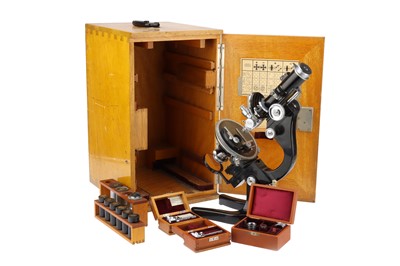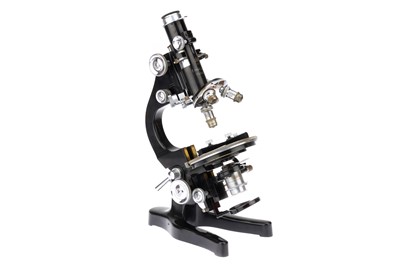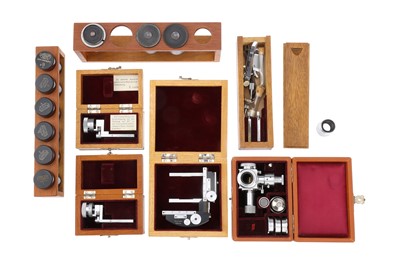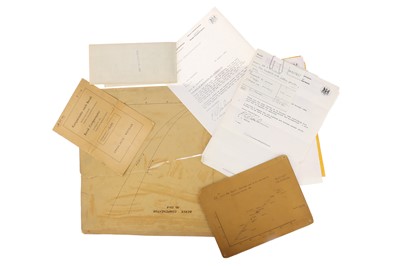24th May, 2023 12:00
Fine Instruments of Science, Medicine and Books
An Important Leitz AM Petrological Microscope From the Geological Survey, With Provenance
German, c.1936, engraved to the front of the body tube 'Ernst Leitz Wetzlar' and 'GS 280' (Geological Society) and engraved on most parts, objectives and eyepieces 'GS280', numbered on the card in the door 323053 the microscope standing on a large and heavy black enameled base, with locking adjustment to the incline, with plano-concave mirror focusing substage condenser with polariser, focusing stage to be used in conjunction with the vertical illuminator so as not to displace the position of the illuminator in relation to an external light source, stage with large removable central section so the microscope can be used with a Universal Stage, body tube with Bertrand lens (along with a hand-drawn chart ) with rack and pinion focusing, analyser with adjustment and scale, in a large wooden case with 7 Leitz objectives 6 of which are engraved GS280, a Berek Compensator engraved GS280 and engraved 1914 along with a hand-drawn chart (damaged), a cased mechanical stage, another Berek compensator engraved GS619
The microscope was sold by the Geological Society back in 1984 to Peter Aubry Sabine for £115.00 and comes with all of the paperwork relating to the sale. According to the records held by the British Geological Society the microscope was bought in 1936 presumably for Dr Phemister, who was recorded as having it in 1937. Dr. Phemister was appointed Official Petrographer in 1935, a post he held until he became Assistant Director in 1946.
Dr James Phemister was a renowned geologist whose contributions to the field of earth sciences were significant. He was born in Scotland in 1903 and spent most of his life working as a geologist in the UK. Dr Phemister's expertise in the field of geology earned him a high reputation among his peers and the scientific community.
Dr Phemister's career began at the University of Edinburgh, where he earned a degree in geology. He then went on to study at the University of Cambridge, where he obtained a PhD in 1928. After completing his studies, Dr Phemister joined the British Geological Survey, where he worked for over 30 years. During this time, he made significant contributions to the study of geology in the UK.
Dr Phemister's work was not limited to the UK, however. He also worked on geological surveys in Africa and South America. In Africa, he worked on a geological mapping project in the Congo, where he discovered the presence of copper deposits. In South America, he worked on a project to map the geology of the Andes mountains, which helped to improve our understanding of the tectonic processes that shape mountain ranges.
Dr Phemister was also an active member of the Geological Society of London, where he played an important role in the development of the society. He was elected a Fellow of the society in 1939 and served as its President from 1953 to 1955. During his tenure as President, Dr Phemister worked to increase the society's membership and promote the study of geology.
Apart from his work with the Geological Society, Dr Phemister was also an accomplished author. He published several books on geology, including "The Geology of Central England" and "The Geology of the South Wales Coalfield." These books were instrumental in advancing our understanding of the geological history of these regions.
Dr Phemister's contributions to geology and earth sciences were recognized by many scientific societies in his lifetime. He was awarded the Wollaston Medal by the Geological Society of London in 1956 for his contributions to the study of geology. He was also awarded the Lyell Medal by the same society in 1966 for his contributions to geological mapping.
In conclusion, Dr James Phemister was a pioneering geologist whose contributions to the field of earth sciences were immense. His work on geological mapping and his involvement in geological surveys in Africa and South America helped to improve our understanding of the geology of these regions. His tenure as President of the Geological Society of London was marked by his efforts to promote the study of geology and increase the society's membership. Dr Phemister's legacy lives on through his numerous publications and his lasting impact on the field of geology.
Peter Aubrey Sabine, (b.1924 - d.2022) was as a prominent British petrologist and mineralogist born in London in 1924. He graduated with a geology degree from Imperial College London in 1945 and joined the Geological Survey and Museum (GSM) as a Geologist. Early in his career, he helped to reorganize the Geological Museum's specimens and showcases, sparking his interest in igneous petrology.
In 1951, he received his PhD for investigating the minor intrusions of the Assynt district in N.W. Highlands. He was later promoted to Chief Petrographer and set about modernizing the Petrographical Department. He realized that the polarizing microscope for the optical characterization of rocks and minerals had been overtaken by more rapid and versatile techniques. He acquired the first X-ray diffraction (XRD) equipment by the late 1950s, followed by X-ray fluorescence (XRF) and differential thermal analysis (DTA) equipment. By the mid-1960s, modern X-ray diffractometer and image analysis equipment were installed, making the Petrographical Department the best equipped and staffed laboratory in the GSM.
Sabine conducted various petrological studies, including contact metamorphism of chalk by Tertiary dolerite intrusions, resulting in several seminal publications. He provided the first detailed petrographical description of the granite found on Rockall, a tiny Atlantic island, after the first landing by the Royal Navy in 1955.
Sabine was the longest-standing member of the Mineralogical Society at the time of his death, having joined in 1945 and becoming Vice President of the Geological Society in 1966. In 1977, he became Chief Geochemist at the Gray's Inn Road office of the renamed British Geological Survey (BGS) and later returned to the Exhibition Road as Deputy Director. However, he retired at the end of 1984 when the BGS relocated its headquarters to a site near Nottingham. Sabine's legacy includes groundbreaking research and modernization in petrology and mineralogy.
German, c.1936, engraved to the front of the body tube 'Ernst Leitz Wetzlar' and 'GS 280' (Geological Society) and engraved on most parts, objectives and eyepieces 'GS280', numbered on the card in the door 323053 the microscope standing on a large and heavy black enameled base, with locking adjustment to the incline, with plano-concave mirror focusing substage condenser with polariser, focusing stage to be used in conjunction with the vertical illuminator so as not to displace the position of the illuminator in relation to an external light source, stage with large removable central section so the microscope can be used with a Universal Stage, body tube with Bertrand lens (along with a hand-drawn chart ) with rack and pinion focusing, analyser with adjustment and scale, in a large wooden case with 7 Leitz objectives 6 of which are engraved GS280, a Berek Compensator engraved GS280 and engraved 1914 along with a hand-drawn chart (damaged), a cased mechanical stage, another Berek compensator engraved GS619
The microscope was sold by the Geological Society back in 1984 to Peter Aubry Sabine for £115.00 and comes with all of the paperwork relating to the sale. According to the records held by the British Geological Society the microscope was bought in 1936 presumably for Dr Phemister, who was recorded as having it in 1937. Dr. Phemister was appointed Official Petrographer in 1935, a post he held until he became Assistant Director in 1946.
Dr James Phemister was a renowned geologist whose contributions to the field of earth sciences were significant. He was born in Scotland in 1903 and spent most of his life working as a geologist in the UK. Dr Phemister's expertise in the field of geology earned him a high reputation among his peers and the scientific community.
Dr Phemister's career began at the University of Edinburgh, where he earned a degree in geology. He then went on to study at the University of Cambridge, where he obtained a PhD in 1928. After completing his studies, Dr Phemister joined the British Geological Survey, where he worked for over 30 years. During this time, he made significant contributions to the study of geology in the UK.
Dr Phemister's work was not limited to the UK, however. He also worked on geological surveys in Africa and South America. In Africa, he worked on a geological mapping project in the Congo, where he discovered the presence of copper deposits. In South America, he worked on a project to map the geology of the Andes mountains, which helped to improve our understanding of the tectonic processes that shape mountain ranges.
Dr Phemister was also an active member of the Geological Society of London, where he played an important role in the development of the society. He was elected a Fellow of the society in 1939 and served as its President from 1953 to 1955. During his tenure as President, Dr Phemister worked to increase the society's membership and promote the study of geology.
Apart from his work with the Geological Society, Dr Phemister was also an accomplished author. He published several books on geology, including "The Geology of Central England" and "The Geology of the South Wales Coalfield." These books were instrumental in advancing our understanding of the geological history of these regions.
Dr Phemister's contributions to geology and earth sciences were recognized by many scientific societies in his lifetime. He was awarded the Wollaston Medal by the Geological Society of London in 1956 for his contributions to the study of geology. He was also awarded the Lyell Medal by the same society in 1966 for his contributions to geological mapping.
In conclusion, Dr James Phemister was a pioneering geologist whose contributions to the field of earth sciences were immense. His work on geological mapping and his involvement in geological surveys in Africa and South America helped to improve our understanding of the geology of these regions. His tenure as President of the Geological Society of London was marked by his efforts to promote the study of geology and increase the society's membership. Dr Phemister's legacy lives on through his numerous publications and his lasting impact on the field of geology.
Peter Aubrey Sabine, (b.1924 - d.2022) was as a prominent British petrologist and mineralogist born in London in 1924. He graduated with a geology degree from Imperial College London in 1945 and joined the Geological Survey and Museum (GSM) as a Geologist. Early in his career, he helped to reorganize the Geological Museum's specimens and showcases, sparking his interest in igneous petrology.
In 1951, he received his PhD for investigating the minor intrusions of the Assynt district in N.W. Highlands. He was later promoted to Chief Petrographer and set about modernizing the Petrographical Department. He realized that the polarizing microscope for the optical characterization of rocks and minerals had been overtaken by more rapid and versatile techniques. He acquired the first X-ray diffraction (XRD) equipment by the late 1950s, followed by X-ray fluorescence (XRF) and differential thermal analysis (DTA) equipment. By the mid-1960s, modern X-ray diffractometer and image analysis equipment were installed, making the Petrographical Department the best equipped and staffed laboratory in the GSM.
Sabine conducted various petrological studies, including contact metamorphism of chalk by Tertiary dolerite intrusions, resulting in several seminal publications. He provided the first detailed petrographical description of the granite found on Rockall, a tiny Atlantic island, after the first landing by the Royal Navy in 1955.
Sabine was the longest-standing member of the Mineralogical Society at the time of his death, having joined in 1945 and becoming Vice President of the Geological Society in 1966. In 1977, he became Chief Geochemist at the Gray's Inn Road office of the renamed British Geological Survey (BGS) and later returned to the Exhibition Road as Deputy Director. However, he retired at the end of 1984 when the BGS relocated its headquarters to a site near Nottingham. Sabine's legacy includes groundbreaking research and modernization in petrology and mineralogy.






